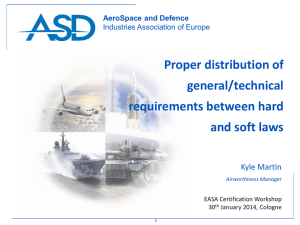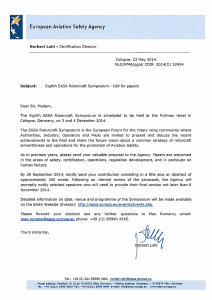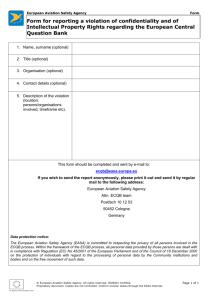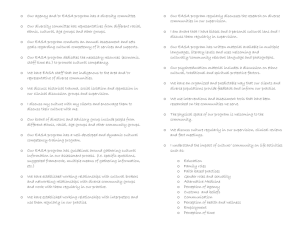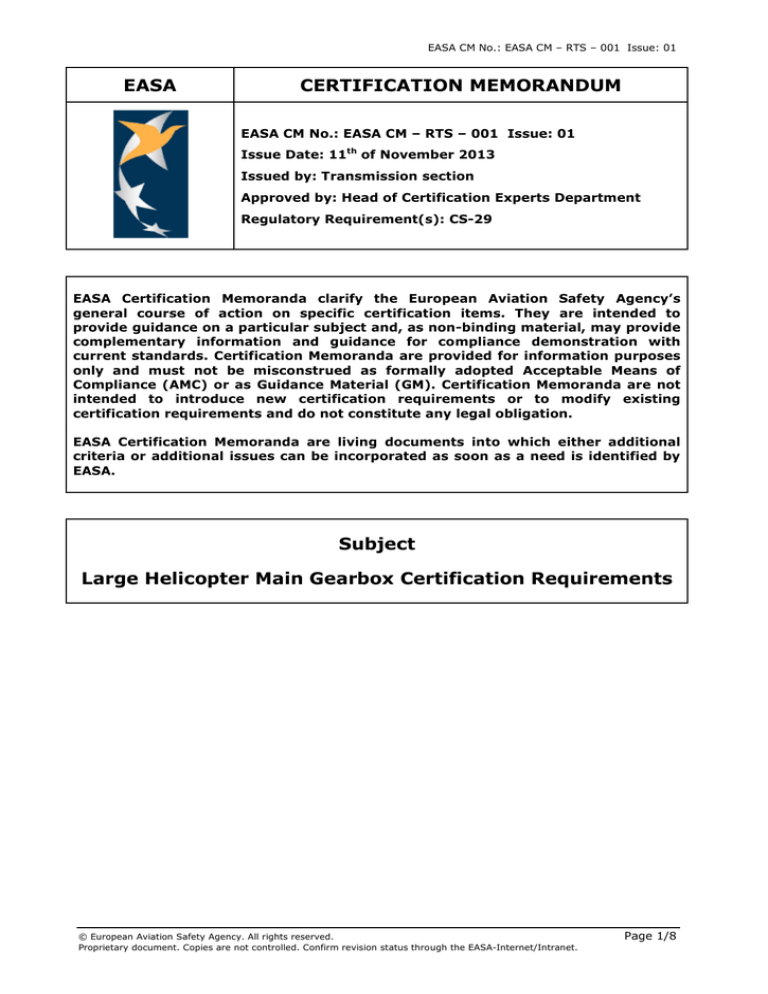
EASA CM No.: EASA CM – RTS – 001 Issue: 01
EASA
CERTIFICATION MEMORANDUM
EASA CM No.: EASA CM – RTS – 001 Issue: 01
Issue Date: 11th of November 2013
Issued by: Transmission section
Approved by: Head of Certification Experts Department
Regulatory Requirement(s): CS-29
EASA Certification Memoranda clarify the European Aviation Safety Agency’s
general course of action on specific certification items. They are intended to
provide guidance on a particular subject and, as non-binding material, may provide
complementary information and guidance for compliance demonstration with
current standards. Certification Memoranda are provided for information purposes
only and must not be misconstrued as formally adopted Acceptable Means of
Compliance (AMC) or as Guidance Material (GM). Certification Memoranda are not
intended to introduce new certification requirements or to modify existing
certification requirements and do not constitute any legal obligation.
EASA Certification Memoranda are living documents into which either additional
criteria or additional issues can be incorporated as soon as a need is identified by
EASA.
Subject
Large Helicopter Main Gearbox Certification Requirements
© European Aviation Safety Agency. All rights reserved.
Proprietary document. Copies are not controlled. Confirm revision status through the EASA-Internet/Intranet.
Page 1/8
EASA CM No.: EASA CM – RTS – 001 Issue: 01
Log of Issues
Issue
01
Issue date
11.11.2013
Change description
First issue.
© European Aviation Safety Agency. All rights reserved.
Proprietary document. Copies are not controlled. Confirm revision status through the EASA-Internet/Intranet.
Page 2/8
EASA CM No.: EASA CM – RTS – 001 Issue: 01
Table of Contents
1.
INTRODUCTION ................................................................................................ 4
1.1.
Purpose and Scope ........................................................................................ 4
1.2.
References ................................................................................................... 4
1.3.
Abbreviations ............................................................................................... 4
1.4.
Definitions .................................................................................................... 4
2. BACKGROUND ................................................................................................... 5
3. EASA CERTIFICATION POLICY .......................................................................... 5
3.1.
EASA Policy .................................................................................................. 5
3.2.
Who this Certification Memorandum Affects ...................................................... 8
4. REMARKS .......................................................................................................... 8
© European Aviation Safety Agency. All rights reserved.
Proprietary document. Copies are not controlled. Confirm revision status through the EASA-Internet/Intranet.
Page 3/8
EASA CM No.: EASA CM – RTS – 001 Issue: 01
1. INTRODUCTION
1.1. PURPOSE AND SCOPE
The purpose of this Certification Memorandum is to provide specific guidance for compliance
with CS 29.927(c) – Lubrication System Failure
This Certification Memorandum describes how a previous amendment to CS 29.927(c), (first
introduced into FAR Part 29 Amendment 29-26, 1988), has caused confusion in
demonstrating compliance. The revised guidance material provided here is intended to clarify
the Agency’s expectations, until a full review and revision of the Certification Specification
can take place.
1.2. REFERENCES
It is intended that the following reference materials be used in conjunction with this
Certification Memorandum:
Reference
Title
Code
Issue
Date
---
Certification Specifications for Large Helicopters
CS-29
---
---
FAA AC 29-2C
Certification of Transport Category Rotorcraft
---
---
---
1.3. ABBREVIATIONS
The following abbreviations are used in this Certification Memorandum:
Abbreviation
Meaning
AC
Advisory Circular
CM
Certification Memorandum
CS
Certification Specification
EASA
European Aviation Safety Agency
FAA
Federal Aviation Administration
FAR
Federal Aviation Requirement
MGB
Main Gear Box
TCCA
Transport Canada Civil Aviation
TSB
Transportation Safety Board
1.4. DEFINITIONS
The following definitions are used in this Certification Memorandum:
Definition
---
Meaning
---
© European Aviation Safety Agency. All rights reserved.
Proprietary document. Copies are not controlled. Confirm revision status through the EASA-Internet/Intranet.
Page 4/8
EASA CM No.: EASA CM – RTS – 001 Issue: 01
2. BACKGROUND
On March 12, 2009, a Canadian-registered Sikorsky S-92A helicopter experienced an inflight loss of lubrication of its main gear box (MGB). The MGB eventually failed, contributing
to a loss of control and subsequent crash. Investigation revealed that the loss of MGB
lubrication was due to failure of the titanium studs for the MGB oil filter. The Canadian
Transportation Safety Board (TSB), in its Accident report A09A0016 dated February 2011,
made two recommendations for changes to the airworthiness design standard pertaining to
the conduct of test of the MGB of Category A helicopters. In addition, the TSB made
recommendations directly to the United States’ Federal Aviation Administration (FAA), as the
Authority of the State of Design for the Sikorsky S-92A.
Transport Canada (TCCA), the FAA and the European Aviation Safety Agency (EASA) have
conducted a joint review of the current design standard and guidance material relating to the
certification of helicopter MGBs. This joint review has been completed and has made a
number of recommendations for future rulemaking. These recommendations will form the
terms of reference of an EASA led rulemaking group which will commence its activity in
2014.
FAA Advisory Circular AC 29-2C provides guidance on failures of interest in the oil system
sub-components (see section AC 29.927 A). This AC is referenced by all three Authorities as
acceptable guidance. However, this AC does not provide any guidance on extremely remote
failure criteria. The 3 Authorities have therefore agreed a revised harmonised text that
amends AC 29.927 and AC 29.927A. The FAA has issued and published this changed AC
section on their website:
http://www.airweb.faa.gov/Regulatory_and_Guidance_Library/rgAdvisoryCircular.nsf/0/47f0
5fca88b954c686257515006ae03e/$FILE/AC_29-2C_Update_2012-07-06.pdf
3. EASA CERTIFICATION POLICY
3.1. EASA POLICY
Revised guidance material acceptable to the Agency in showing compliance with CS
29.927(c) is provided as follow:
AC 29.927.
§ 29.927 (Amendment 29-17) ADDITIONAL TESTS.
* * * * *
c. Section 29.927(c):
(1) Explanation.
(i) This section prescribes a test to demonstrate that any failure
resulting in the loss of lubrication pressure to the rotor drive primary oil system will not
impair the capability of the rotorcraft to operate under autorotative conditions for 15
minutes.
(ii) The regulation is intended to apply to pressurized lubrication
systems and has not been applied to splash lubricated gearboxes since historically their
design has not been as critical or complex when compared to pressurized systems. The
likelihood of loss of lubrication is significantly greater for transmissions that use pressure
lubrication and external cooling. This is due to the increased complexity of the lubrication
system and the external components that circulate oil outside the gearbox. A pressure
lubrication system is more commonly used in the rotorcraft’s main transmission but may
also be used in auxiliary transmissions or gearboxes.
(iii) The lubricating system has two primary functions. The first is to
provide lubricating oil to contacting or rubbing surfaces and thus reduce friction losses. The
© European Aviation Safety Agency. All rights reserved.
Proprietary document. Copies are not controlled. Confirm revision status through the EASA-Internet/Intranet.
Page 5/8
EASA CM No.: EASA CM – RTS – 001 Issue: 01
second is to dissipate heat energy generated by friction of meshing gears and bearings thus
maintaining surface and material temperature. Accordingly, a loss of lubrication leads to
increased friction between components and increased component surface temperatures.
With increased component surface temperatures, component surface hardness can be lost
resulting in the inability of the component to carry or transmit loads. Thermal expansion in
transmission components can eventually lead to the mechanical failure of bearings, journals,
gears, shafts, and clutches that are subjected to high loads and rotational speeds. A
significant loss of lubrication may result from internal and external failures. Failures include,
but are not limited to, oil lines, fittings, seal plugs, sealing gaskets, valves, external pumps,
oil filters, oil coolers, accessory pads, etc. A leak caused by a crack in the transmission
outer case need not be considered as a source of a loss of lubrication provided the outer
case has been structurally substantiated to satisfy the requirements of §§ 29.307,
29.923(m), and 29.571.
(2) Procedures. Conventionally, a bench test (transmission test rig) is used to
demonstrate compliance with this rule. Since this is essentially a durability test of the
transmission to operate with residual oil, typically the worst case failure (i.e., the
undrainable oil or the oil remaining after a severe pressure leak, whichever results in a
greater loss of oil in the transmission’s normal lubrication system) is used as a critical entry
point for the test. The transmission should be stabilized at the torque associated with
maximum continuous power (reacted as appropriate at main mast and tail rotor output
quills) at a normal main rotor speed, oil temperature that is at the highest limit for
continuous operation, and oil pressure that is within the normal operating range. A vertical
load should be applied at the mast, equal to the gross weight of the rotorcraft at 1g. Once
the transmission oil temperature is stabilized, simulate the worst case failure in the normal
use lubrication system. Upon illumination of the low oil pressure warning device (required
by § 29.1305), reduce input torque to simulate an autorotation and continue transmission
operation for 15 minutes. To complete the test, apply an input torque to the transmission
for approximately 10 seconds to simulate a minimum power landing.
A successful
demonstration may involve limited damage to the transmission, provided it is determined
that the autorotative capabilities of the rotorcraft were not significantly impaired.
* * * * *
AC 29.927A.
§ 29.927 (Amendment 29-26) ADDITIONAL TESTS.
a. Section 29.927(c):
(1)Explanation.
(i) Amendment 29-26 revised the rotor drive system loss of lubrication
test requirements for Category A rotorcraft in § 29.927(c). This requires testing to show
that any failures that result in a loss of lubrication in any normal use lubrication system,
unless the failures are extremely remote, will not prevent continued safe flight for at least 30
minutes after the flight crew recognizes the loss of lubricant failure.
(ii) The introductory phrase to this amendment to the regulation,
“unless such failures are extremely remote” has caused confusion. The NPRM did not
contain this expression and the only change documented in the preamble to the final rule
(53 FR 34204) explains that the final rule was revised in response to a public comment that
the proposed regulation could be interpreted to “preclude credit for auxiliary lubrication
systems or to require consideration of lubricant failures to self-lubricated bearings.” This
was not intended and the final rule was “revised to eliminate this ambiguity.” The phrase,
“unless such failures are extremely remote,” was introduced to resolve the public comment
to convey that the applicant does not have to consider failures that may exist in the auxiliary
lubrication system prior to performing the loss of lubrication testing. Under the current
regulation, the extremely remote language in the final rule means that testing to
demonstrate at least 30 minutes continued flight capability (for Category A), following loss of
© European Aviation Safety Agency. All rights reserved.
Proprietary document. Copies are not controlled. Confirm revision status through the EASA-Internet/Intranet.
Page 6/8
EASA CM No.: EASA CM – RTS – 001 Issue: 01
lubrication in the normal lubrication system, is not required if the failures leading to that loss
of lubrication condition are determined to be extremely remote. While this compliance
approach is allowed, it may not be achievable due, in part, to the unforeseen variables and
complexity associated with predicting potential lubrication failure modes and their associated
criticality and frequency of occurrence. This includes considering lubrication failures that
may result from improper transmission maintenance and servicing.
The expected
compliance approach is to assume a failure in the normal lubrication system leading to rapid
loss of lubrication and to rely on an auxiliary lubrication system or the robustness of the
transmission components to accomplish at least 30 minutes of operation (for Category A) at
the prescribed conditions. With this approach, the normal and auxiliary systems must be
independent in order to preclude common loss of lubrication failure points and possible cross
contamination. Compliance with § 29.1309 would only apply to any electrical and software
design aspects of the normal and auxiliary lubrication systems. The auxiliary lubrication
system must also be designed, constructed, and functionally tested to show that it can
perform its intended function.
(iii) The regulation is intended to apply to pressurized lubrication
systems and has not been applied to splash lubricated gearboxes since historically their
design has not been as critical or complex when compared to pressurized systems. The
likelihood of loss of lubrication is significantly greater for transmissions that use pressure
lubrication and external cooling. This is due to the increased complexity of the lubrication
system and the external components that circulate oil outside the gearbox. A pressure
lubrication system is more commonly used in the rotorcraft’s main transmission but may also
be used in auxiliary transmissions or gearboxes.
(iv) The lubricating system has two primary functions. The first is to
provide lubricating oil to contacting or rubbing surfaces and thus reduce friction losses. The
second is to dissipate heat energy generated by friction of meshing gears and bearings thus
maintaining surface and material temperature. Accordingly, a loss of lubrication leads to
increased friction between components and increased component surface temperatures.
With increased component surface temperatures, component surface hardness can be lost
resulting in the inability of the component to carry or transmit loads. Thermal expansion in
transmission components can eventually lead to the mechanical failure of bearings, journals,
gears, shafts, and clutches that are subjected to high loads and rotational speeds. A loss of
lubrication may result from internal and external failures. Failures include, but are not
limited to, oil lines, fittings, seal plugs, sealing gaskets, valves, pumps, oil filters, oil coolers,
accessory pads, etc. A leak caused by a crack in the transmission outer case need not be
considered as a source of a loss of lubrication, provided the outer case has been structurally
substantiated to satisfy the requirements of §§ 29.307, 29.923(m), and 29.571.
(v) The intent of the rule change for Category A rotorcraft was to
assure that these rotorcraft have significant continued flight capability after the loss of
lubricant to any single transmission in order to optimize eventual landing opportunities.
Extending the bench testing beyond 30 minutes, although not required, is considered highly
desirable. Accomplishing this would further improve the capability of the rotorcraft to reach
a suitable landing location in order to improve occupant safety when operating in remote
geographic areas that include harsh environmental conditions. Indefinite flight with a
lubrication system failure is not expected. However, it may be acceptable to include a time
interval in the emergency procedures. That time interval should be reduced sufficiently when
compared to the bench test demonstration to allow for an adequate safety margin.
(2) Procedures.
(i) Section 29.927(c) prescribes a test to demonstrate that the effects
of a loss of lubrication will not impair the ability of category A rotorcraft to continue safe
powered operation for at least 30 minutes after illumination of the low oil pressure warning
device (required by § 29.1305). For Category B rotorcraft, § 29.927(c)(2) prescribes the
tests for safe operation under autorotative conditions must continue for at least 15 minutes.
(ii) An acceptable means of demonstrating compliance with this rule is
through the use of a bench test (transmission test rig). Since this is essentially a durability
© European Aviation Safety Agency. All rights reserved.
Proprietary document. Copies are not controlled. Confirm revision status through the EASA-Internet/Intranet.
Page 7/8
EASA CM No.: EASA CM – RTS – 001 Issue: 01
test of the transmission to operate with residual oil, typically the worst case failure (i.e., the
undrainable oil or the oil remaining after a severe pressure leak, whichever results in a
greater loss of oil in the transmission’s normal use lubrication system) is used as a critical
entry point for the test, see paragraph a.(2)(iii).
(iii) The transmission should be stabilized at the torque associated with
maximum continuous power (reacted as appropriate at the main mast and tail rotor output
quills) at a normal main rotor mast speed, oil temperature that is at the highest limit for
continuous operation, and oil pressure that is within the normal operating range. A vertical
load should be applied at the mast, equal to the gross weight of the rotorcraft at 1g. Once
the transmission oil temperature is stabilized, simulate the worst case failure in the normal
use lubrication. Upon illumination of the low oil pressure warning device (required by
§ 29.1305), reduce the input torque for category A rotorcraft to the minimum torque
necessary to sustain flight and continue the test for at least 30 minutes at the maximum
gross weight and the most efficient flight conditions. To complete the test, apply an input
torque to the transmission for approximately 25 seconds to simulate an autorotation. The
last 10 seconds (of the 25 seconds) should be at the torque required for a minimum power
landing. A successful demonstration may involve limited damage to the transmission,
provided it is determined that the autorotative capabilities of the rotorcraft were not
significantly impaired. For category B rotorcraft, upon illumination of the low oil pressure
warning device, reduce the input torque to simulate an autorotation and continue
transmission operation for 15 minutes. To complete the test, apply an input torque to the
transmission for approximately 10 seconds to simulate a minimum power landing. A
successful demonstration may involve limited damage to the transmission provided it is
determined that the autorotative capabilities of the rotorcraft were not significantly impaired.
If compliance with Category A requirements is demonstrated, Category B requirements will
have been met.
3.2. WHO THIS CERTIFICATION MEMORANDUM AFFECTS
Designers of large helicopters
4. REMARKS
1. Suggestions for amendment(s) to this EASA Certification Memorandum should be
referred to the Certification Policy and Planning Department, Certification Directorate,
EASA. E-mail CM@easa.europa.eu or fax +49 (0)221 89990 4459.
2. For any question concerning
Memorandum, please contact:
the
technical
content
of
this
EASA
Certification
Name, First Name: HEALEY, Alastair
Function: Acting Transmission Section Manager/Transmission Expert Rotorcraft
Phone: +49 (0)221 89990 4079
Facsimile: +49 (0)221 89990 4579
E-mail: alastair.healey@easa.europa.eu
© European Aviation Safety Agency. All rights reserved.
Proprietary document. Copies are not controlled. Confirm revision status through the EASA-Internet/Intranet.
Page 8/8

